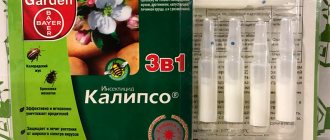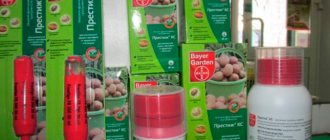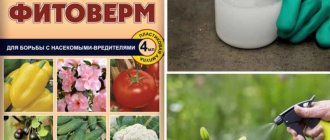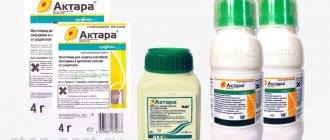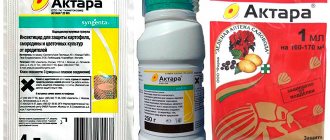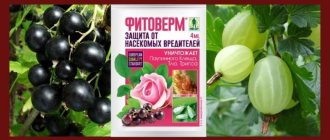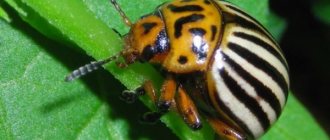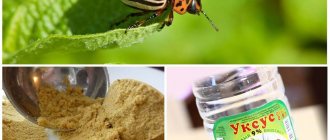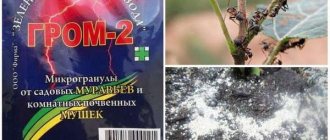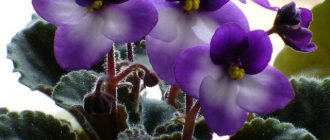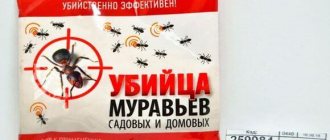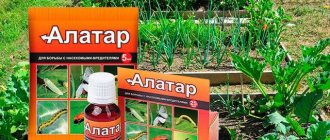Mechanism of action of the drug
When treating cultivated plants with the insecticide Bi 58, the chemical solution directly hits the pests and quickly penetrates the soft tissues of insects (larvae) and their chitinous cover. Dimethoate acts neuroparalytically at the cellular level, causing the death of parasites.
The working solution of the pesticide, prepared according to the instructions, is absorbed by plants during processing and remains in their cell sap for about 25 days. Pests, devouring green plant matter, receive a lethal dose of toxin. This expresses the systemic effect of the drug. Precipitation does not affect its effectiveness.
Application of Bi-58
Advantages and disadvantages
The drug Bi 58 has proven itself to be a highly effective and reliable product. It has several advantageous differences from other insecticides. These include:
- Wide spectrum of antiparasitic action. Bi 58 and modification Bi 58 New are active even against insects that are resistant to other pesticides.
- Compatibility with other chemicals for the care of agricultural and ornamental plants. It can be used simultaneously with fungicides. Not recommended for use with alkaline products.
Bi 58 can be used in combination with other drugs against herbivorous insects - No toxic effects on plants.
- Wide range of temperatures at which the product can be used.
- Very quick effect of use.
- Possibility of spraying plants with the drug throughout the growing season. However, 3-4 weeks before the start of harvest, the use of the insecticide should be stopped.
- Moderate cost compared to other insecticides.
Like all chemicals, insecticide Bi 58 also has some disadvantages. These include:
- strong unpleasant odor;
- there is a high risk of harming the plant if the dosage is violated. Although formally the drug belongs to the third class of danger poisons, experienced plant growers tend to classify Bi 58 as a second class;
When using Bi 58, there is a high risk of harming the plant by violating the dosage
- Difficult to use in enclosed spaces with poor ventilation. When treating indoor flowers, it is better to use softer products;
- danger to pollinating insects and fish;
- the possibility of skin reactions and irritation of mucous membranes when working without personal protective equipment.
The insecticide is mildly toxic to humans and warm-blooded animals, but should be used with caution.
How to breed Bi 58
In small garden plots, 5 ml packaging of the drug is more often used to treat cultivated crops. The instructions for use indicate that to prepare the solution, the pesticide is diluted with water in the proportion: 1 ml Bi 58 per 1 liter of liquid. Increasing the dosage leads to burns of plants: they turn yellow, shed leaves and may die.
Bi-58 consumption in the table
Composition and action
DV Bi-58 dimethoate (formula in the figure on the right) belongs to the chemical class of organophosphorus compounds (OPS). The mechanism of action is a nerve poison (neurotoxin) that blocks the enzyme-mediator cholinesterase. The result is failure of nerve impulses to reach the muscles, convulsions, paralysis and death.
Chemical formula of dimethoate, the active ingredient of the Bi-58 pesticide, and its structural model
Toxicology
Like other neurotransmitter (transport enzyme) blockers, dimethoate is a rather slow but very strong poison. It is weakly selective towards taxonomic groups of animals, because Cholinesterase is a universal mediator of nervous control of muscles. The toxicity of dimethoate for warm-blooded animals increases with increasing metabolic rate, so working with Bi-58 in hot weather requires additional precautions, and for birds this pesticide is almost less dangerous than for the objects being eliminated. Also - for fish and aquatic organisms due to good solubility in water (39 g/l); the same factor determines the environmental hazard of the drug in rainy weather.
For humans, Bi-58 is especially dangerous in case of inhalation (inhalation) of splashes of the working solution (this is what causes accidents in agricultural production) or contact with mucous membranes. Inhalation of vapors is less (but still very) dangerous, because The volatility of the additive is low (0.107 mg/cubic m at +25 degrees Celsius). It is also very dangerous if the drug gets on the body, because it is quickly, within a few minutes, completely absorbed into the body through dry, intact skin (through mucous membranes - instantly). Toxicological indicators of dimethoate are close to threatening:
- LD50 for rats 230 mg/kg body weight; for mice 135 mg/kg;
- ADI for humans is 0.002 mg/kg.
- TAC in soil is 0.1 mg/kg.
- MPC in water of reservoirs is 0.003 mg/cubic meter. dm social-t.
- The maximum permissible concentration in the air of the working area is 0.5 mg/m3. m.
- MPC in atmospheric air is 0.0003 mg/cubic meter. m s.-s.
Note: the content of dimethoate vapor in the air is 10 mg/m3. m is 100% lethal for rats, and 3 mg/cu. m for most laboratory animals. The lethal dose of dimethoate applied to the skin of mammals ranges from 1-1.5 g/kg.
Acute poisoning with dimethoate develops gradually, over 1-3 days. Initial symptoms are general weakness and drowsiness. Then you feel chills, nausea, vomiting, and profuse sweating begin. In case of moderate poisoning, this is followed by tremors, loss of coordination of movements, a wobbly “drunk” gait, and constriction of the pupils. In case of severe poisoning, clonic convulsions begin, turning into local paralysis, then a coma is observed. Death occurs due to impaired cardiovascular activity. There is no specific antidote, treatment is symptomatic.
Application of Bi 58
The drug Bi 58 can be used throughout the entire growing season of cultivated plants, with the exception of the last 40 days before harvesting. Pest eggs sometimes remain viable after a single pesticide treatment, so if the plantation is heavily infested with parasites, spraying must be repeated after 2 weeks. The Bi 58 solution prepared according to the instructions is used for the following crops (consumption is indicated for 1 hectare of agricultural land):
| Plant | Its pests | Required amount of drug in liters |
| wheat | bug, grain fly, thrips, aphid | 1,5 |
| barley and other grains | 1,0–1,3 | |
| potato | nematode, Colorado potato beetle, wireworm | 1,6–2 |
| roots | tick, fatty leg | 0,5–1 |
| pulses | weevil, codling moth, aphid, pea weevil | 0,5–1 |
| fruit trees | caterpillar, moth, scale insect | 0,8–2 |
| raspberries | galitza, cicada, tick | 0,6–1,2 |
| grape | wood borer, leaf roller, aphid | 1,2–3 |
“BI-58 New” - instructions for use taking into account all the dangers
Despite such a wide range of effects of the pesticide, it is very harmful and dangerous for humans, bees, fish and warm-blooded animals. Therefore, they are prohibited from spraying flowering plantings, otherwise they could destroy their apiary. In addition, it is recommended to carry out the last processing of the land 30 days before the start of harvest. At the same time, you should avoid getting the chemical into ponds or other water sources.
In enclosed spaces, it is planned to treat plants no more than 2 times a year: in spring or at the end of summer. After the procedure, be sure to ventilate the room.
Many gardeners are interested in when to spray their plants with the BI-58 insecticide. According to the instructions, this is done during the growing season, as well as at a temperature of +20-28˚С. Under such conditions, the effect of active substances reaches its maximum value.
The dosage of the working solution for each crop is as follows:
- Grape. The pesticide will need 1.2-2.8 liters per 1 hectare of planting or 10 liters per 30 m². The waiting period is a month.
- Potatoes - 2 l/ha, up to 20 days.
- Vegetable crops - 500-900 ml/ha.
- Pear and apple tree - 2-5 liters of solution per tree. Treatment is carried out before or after flowering. The effect is observed for 40 days, as indicated in the instructions for use “BI-58 new”.
- Raspberries, currants and gooseberries. There is up to 1.2 liters of solution per hundred square meters.
- Sugar beet - 0.5-1 l/ha per month.
- Winter wheat, oats, rye and other cereals - 1-1.5 l/ha with effect for up to 30 days.
- Ornamental/indoor plants and shrubs - 1 l/m².
With the exception of apple and pear trees, spraying is recommended during the growing season. The maximum number of treatments is 2 times per season. The interval between them is the waiting period indicated on the package. For different crops it lasts 20, 30 or 40 days.
Don't forget about precautions. Goggles, gloves, a mask and tight-fitting clothing/gown must be used. After pickling, be sure to wash your hands (up to the elbows) and face with soap.
How to dilute the drug “BI-58 new”
The preparation of the solution largely depends on the degree of infestation of the planting, the “appetite” of the pests and the type of crop. Manufacturers usually indicate on the packaging how to dilute “BI-58 new”. Basically, for 10 liters of liquid, in rare cases for 20 liters, you will need 10 ml (2 ampoules) of the chemical. To combat mole crickets, agronomists advise applying the insecticide directly to the soil.
When planting tubers, seedlings or seeds, prepare bait:
- fry corn, grains, dirt or mixed feed (up to 6 kg);
- 10 ml of the drug is mixed with aromatic food;
- leave to infuse for 2-3 hours;
- during planting, they are embedded in the soil to a depth of 3 cm.
To prepare the solution you need soft water. Impurities of clay or other rocks lead to modification of the concentrate. Moreover, experts recommend heating the liquid to 20˚C.
It is worth noting that the shelf life of “BI-58 new” is no more than 2 years. Store the container with the drug in a dry and fairly cool place. It is noteworthy that 1 liter of this liquid contains 400 ml of a toxic substance. For this reason, the emulsion is hermetically sealed and packaged in a bag or box. Keep it away from children, food and fire.
Having examined the instructions for use of the new generation “BI-58”, you can see that this is a very poisonous insecticide. The consumption of the product depends on the degree of plant infestation. The pesticide (2 ampoules of 5 ml each) is diluted in 10 liters of soft and slightly warmed water. A spray bottle is used for spraying. Repeated treatment is planned in 30-40 days. Using this insecticide to treat insect pests, the farmer will greatly simplify their care and protect his crop.
Special instructions and precautions
When using Bi 58 to protect plants from pests, the following safety precautions must be observed:
- All work on preparing the working solution and using the chemical must be carried out in closed shoes, a suit, rubber gloves, a respirator and safety glasses.
- It is recommended to dilute the product with water immediately in a garden sprayer bottle.
- After irrigating the plants with insecticide, wash the equipment and take a shower with soap.
- Do not pour the remaining chemical onto the ground or into a body of water.
- Bi 58 belongs to hazard class 3, toxic to bees and fish. Before using this pesticide, it is necessary to limit the access of pets to the garden.
- Plants treated with insecticide can be eaten no earlier than 40 days after spraying.
Preparing the garden sprayer for use
Compatibility with other drugs
It is allowed to combine this product with other chemical compounds aimed at destroying fungal infections on plants. We talked about some of the best drugs for potato moth here, and in this article you can read about other popular and effective means of combating this pest.
Do not combine with drugs that contain alkali.
Terms of sale and storage
The chemical must be stored in a dark place away from children and animals. The optimal storage temperature is + 18-25°C. The shelf life of Bi 58 is 2 years from the date of issue (indicated on the label). The working solution prepared according to the instructions cannot be stored. After use, its residues should be disposed of.
Use of Bi-58
Precautionary measures
Security zones for working with Bi-58 and other dimethoate preparations are established as follows:
- Apiary – 6 km. There is no restriction on the flight of bees, because biologically and technically impracticable for the duration of the protective effect of the drug (10-14 days). Warning beekeepers about upcoming processing no earlier than 5 days, because migration of apiaries from the protected zone is mandatory.
- Natural productive lands (mushrooms, berries) – 3 km. Collect mushrooms and berries in the protected zone no earlier than 60 days after using the drug. Collecting wild flowers and medicinal herbs there - not earlier than the next growing season
- Reservoirs, water supply sources - according to their water protection zone, but not closer than 1.5 km.
- Children's, medical and recreational institutions, public recreation areas - 500 m.
- The distance from the nearest residential buildings to industrial premises/areas for the preparation of working fluid, reloading and filling points/sites is at least 500 m.
- Residential buildings, premises and areas for keeping animals, open storage of food products - 150 m.
- Temporary inhabited premises (including industrial premises for people), closed food storage facilities - 50 m.
- Other outbuildings that are not subject to planting treatment – 15 m.
Hazard class Bi-58 for people is 3 (moderately dangerous), but due to its high inhalation activity and skin-resorptive ability, no relaxations in the composition of PPE (see figure) are unacceptable.
Personal protective equipment for working with insectoacaricide Bi-58
Professional workers should handle Bi-58 in protective overalls, ensuring complete isolation of the body from vapors and splashes of the drug. For small farmers and owners of private household plots who use Bi-58 occasionally, the overalls can replace a raincoat suit made of calender fabric, which has a tight-fitting hood with an elastic band on the head.
For infrequent work with dimethoate preparations (1-2 times a season), a petal respirator that protects against splashes is suitable, always supplemented with safety glasses with a face seal. Professionals who constantly work with pesticides must wear a filtering respirator with a full-face mask (see figure on the right), which prevents direct contact of the drug with the skin.
Filtering respirator with full face mask
For the same purpose, work shoes should be chemically resistant and waterproof, and protective gloves should be 2-3 layer latex with high gauntlets that fit over the sleeves. Neutralization of work clothes - washing with laundry soap (Bi-58 is unstable in an alkaline environment) and rinsing with water. Neutralization of shoes and gloves - 3-4 tsp baking soda solution. per glass of water and rinse with water. The respirator and glasses are neutralized according to the instructions for them.
In case of direct contact with Bi-58 or the appearance of any illness during work, you should immediately stop working and consult a toxicologist. First, within no more than 10-20 minutes, first aid/self-help measures are taken:
- In case of contact with skin, remove wet clothing, treat the affected area without rubbing it with a cotton swab moistened with soda solution (see above) and rinse with water. It’s better to wash in the shower with soap; neutral saponin and synthetic detergents do not neutralize dimethoate.
- In case of contact with eyes, rinse them thoroughly with open eyes under running water.
- In case of contact with mucous membranes: if a burning sensation or camphor taste is felt (if it gets into the mouth), rinse with a soda solution, then with water. If there are no symptoms of damage, run to the doctor, it has already been absorbed.
- If ingested, take 3-4 tablets or activated carbon powder with a glass of water, wash down with 3-4 glasses of water, induce vomiting.
- During inhalation, take the victim to a doctor as soon as possible, accompanied by a known healthy person who can provide assistance to the patient along the way.
Note, once again : after providing first aid measures, consult a doctor immediately!
Insectoacaricide Bi-58 is stored under the usual conditions for agrochemicals: in a separate non-residential premises, inaccessible to children and animals. You cannot store food products, medicines, medical supplies, clothes and shoes (including work shoes) and household items there. Neutralize spills on the floor with a soda solution, followed by rinsing with water. Neutralization of spills on the ground - collect the soaked soil and a layer of 5-10 cm around it, heat it with fire or send it to an incinerator. Disposal of empty containers is also done in a waste incinerator.
Analogs
If for some reason the selected plant protection product against pests is not available, you can use a product with a similar effect. Insecticide Bi 58 has analogues in which the active substance is also dimethoad:
- Rogor. The drug is available in the form of a concentrated solution in 10 liter canisters. The dimethoate content in Rogor is 400 ml per 1 liter of the drug. When the product comes into contact with a pest, there is an immediate paralytic effect. The death of the insect occurs within 3 hours. The drug has a prolonged effect - protection of treated crops lasts up to 20 days.
- Phosfamide is an organophosphate chemical. Dimethoad, the active ingredient, makes up 40% of the drug. The insecticide poisons pests through contact and systemic effects on crop parasites when they eat treated plant parts. Phosfamide is sold in 10 liter canisters.
- Emphasis – contact-intestinal poison against insect pests. Destroys parasites at all stages of development. The content of dimethoad is similar to the drugs described above. The insectoacaricide is used to destroy many insect pests on plantations of wheat, barley, sugar beets, vineyards, apple trees, peas and other crops.
- Dimethrin is an organophosphate insecticide in the form of a concentrated emulsion. 1 liter of the drug contains 400 ml of dimethoad, a neuroparalytic substance that paralyzes pests on agricultural crops with their subsequent destruction. It is toxic to humans, therefore it requires preparation of the working solution strictly according to the instructions and compliance with safety precautions during use.
When and where is the product used?
The drug Bi 58 protects all parts of plants, including newly growing ones, from pests. The insecticide is well tolerated by most crops. It can be used to process:
Read on topic:
Sulfur ointment: instructions for use, price and reviews
15.10.2019
Get Total - a modern means for effective control of insects
25.06.2019
Getting rid of cockroaches and bedbugs with Xulat Micro
25.06.2019
Xulat C25 - a powerful modern remedy for cockroaches and bedbugs
25.06.2019
- cereal crops - wheat, oats, millet, barley;
- leguminous plants;
- fruit trees - apples, pears, plums;
The drug Bi 58 will help protect fruit trees from herbivorous parasites
- vineyards;
- citrus fruits;
- vegetable crops - beets, cabbage, potatoes;
- berry bushes - raspberries, currants, gooseberries;
When treating berry bushes with Bi 58, the drug will help kill the insects that live on them
- alfalfa and flax.
In addition to use in garden plots and farmland, the drug can be used to treat indoor plants and treat plantings in greenhouses.
The insecticide has a wide spectrum of action. It is most often used to combat the Colorado potato beetle at all stages of development of this insect. In addition, the drug helps cope with different groups of pests:
- sawfly beetles;
- aphids and thrips;
- bedbugs;
The product Bi 58 not only helps in the fight against the Colorado potato beetle, but can also help get rid of bedbugs
- caterpillars;
- codling moths;
- butterflies - cutworms, moths, leaf rollers, etc.;
- flies and whiteflies, as well as their larvae;
- flea beetles that parasitize plants;
- mites and scale insects.
Price Bi 58
| Seller (Moscow) | Volume | Cost in rubles |
| LLC "Vozrozhdenie" | 5 l | 750 per 1 l (for orders over 40 l) |
| Sadovod store, Zeleny pr., 3A | 5 ml | 35 |
| 2 x 5 ml | 60 | |
| BAU BASE LLC | 10 l | 4400 |
| RADONEZH-AGRO | 5 ml | 30 |
| DEZ24 | 5 l | 4500 |
| Trading house "Brig" | 5 ml | 16 |
